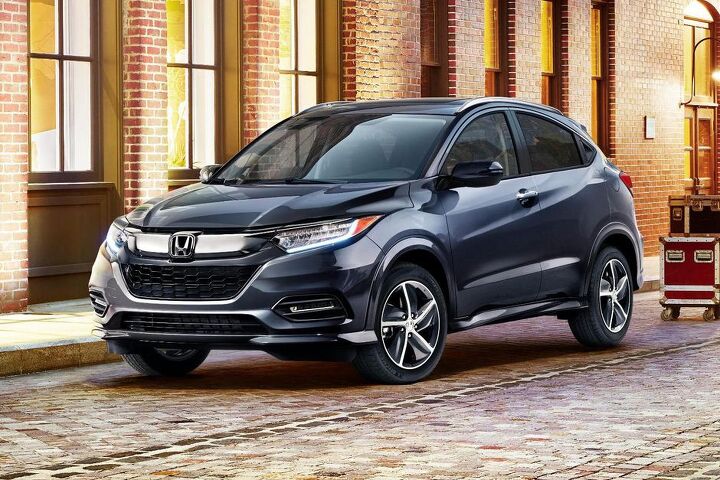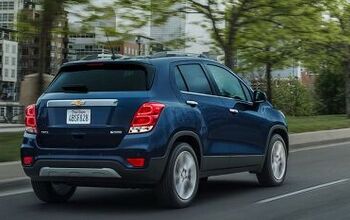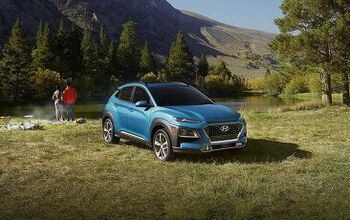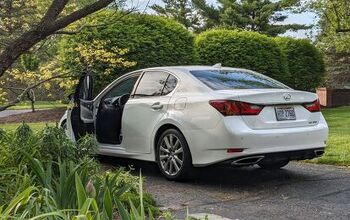Buy/Drive/Burn: Affordable Japanese Subcompact Crossovers in 2021

In our last edition of Buy/Drive/Burn, we took a look at three subcompact American CUVs competing at the $25,000 price point. Most of you seemed to agree they were all terrible, but the Trax edged out the Buy in the comments.
Let’s see how you feel about the Japanese competition.
Honda HR-V
On sale elsewhere since 2013, Honda’s HR-V made its way to North America in 2016. On the same platform as the Fit, the HR-V was refreshed in 2019 with a new grille and more LED goodness, most of it designed to make it look more familiar to Civic customers. The HR-V is available in LX, Sport, EX, and EX-L trims, and all-wheel drive is available at all levels. Today’s budget nets us a low-level Sport AWD. Priced at $24,470, the HR-V uses a 1.8-liter inline-four for 141 horsepower and wrangles those horses with a CVT.
Mazda CX-30
The CX-30 is the newest competitor of our trio. Introduced for 2020, CX-30 occupies a similar market space as Mazda’s other subcompact crossover, CX-3. CX-3 uses the old Mazda 2 platform, while the larger CX-30 is a Mazda 3 underneath. CX-30 is available in seven different trims, from Base to Turbo Premium Plus. Front- and all-wheel drive are available throughout the range. Today’s version is a lower-level Select Package AWD for $25,300. Power arrives via the 3’s 2.5-liter inline-four, which produces 186 horsepower. The transmission is a six-speed auto, also from the 3.
Toyota C-HR
The CH-R arrived for the 2017 model year as Toyota’s smallest crossover. Based on Corolla, the CH-R was initially intended to wear a Scion badge before that marque’s untimely demise. In a strange product planning decision, the CH-R is the only car here to forego an all-wheel-drive option. However, in other markets, the CH-R is available with all-wheel drive, which means Toyota would prefer you purchase the more expensive RAV4 if you’re in North America. There are four CH-R trims: LE, XLE, Nightshade, and Limited. Today’s budget mandates a Nightshade, which has lots of black trim and additional trim-specific paint options. CH-R is powered by a 2.0-liter engine from the Corolla, good for 144 horsepower, and all CH-Rs use a CVT in North America.
Three Japanese crossovers asking for your dollars, which one’s worth buying?
[Images: Honda, Mazda, Toyota]

Interested in lots of cars and their various historical contexts. Started writing articles for TTAC in late 2016, when my first posts were QOTDs. From there I started a few new series like Rare Rides, Buy/Drive/Burn, Abandoned History, and most recently Rare Rides Icons. Operating from a home base in Cincinnati, Ohio, a relative auto journalist dead zone. Many of my articles are prompted by something I'll see on social media that sparks my interest and causes me to research. Finding articles and information from the early days of the internet and beyond that covers the little details lost to time: trim packages, color and wheel choices, interior fabrics. Beyond those, I'm fascinated by automotive industry experiments, both failures and successes. Lately I've taken an interest in AI, and generating "what if" type images for car models long dead. Reincarnating a modern Toyota Paseo, Lincoln Mark IX, or Isuzu Trooper through a text prompt is fun. Fun to post them on Twitter too, and watch people overreact. To that end, the social media I use most is Twitter, @CoreyLewis86. I also contribute pieces for Forbes Wheels and Forbes Home.
More by Corey Lewis
Latest Car Reviews
Read moreLatest Product Reviews
Read moreRecent Comments
- NJRide So if GM was serious about selling this why no updates for so long? Or make something truly unique instead of something that looked like a downmarket Altima?
- Kmars2009 I rented one last fall while visiting Ohio. Not a bad car...but not a great car either. I think it needs a new version. But CUVs are King... unfortunately!
- Ajla Remember when Cadillac introduced an entirely new V8 and proceeded to install it in only 800 cars before cancelling everything?
- Bouzouki Cadillac (aka GM!!) made so many mistakes over the past 40 years, right up to today, one could make a MBA course of it. Others have alluded to them, there is not enough room for me to recite them in a flowing, cohesive manner.Cadillac today is literally a tarted-up Chevrolet. They are nice cars, and the "aura" of the Cadillac name still works on several (mostly female) consumers who are not car enthusiasts.The CT4 and CT5 offer superlative ride and handling, and even performance--but, it is wrapped in sheet metal that (at least I think) looks awful, with (still) sub-par interiors. They are niche cars. They are the last gasp of the Alpha platform--which I have been told by people close to it, was meant to be a Pontiac "BMW 3-series". The bankruptcy killed Pontiac, but the Alpha had been mostly engineered, so it was "Cadillac-ized" with the new "edgy" CTS styling.Most Cadillacs sold are crossovers. The most profitable "Cadillac" is the Escalade (note that GM never jack up the name on THAT!).The question posed here is rather irrelevant. NO ONE has "a blank check", because GM (any company or corporation) does not have bottomless resources.Better styling, and superlative "performance" (by that, I mean being among the best in noise, harshness, handling, performance, reliablity, quality) would cost a lot of money.Post-bankruptcy GM actually tried. No one here mentioned GM's effort to do just that: the "Omega" platform, aka CT6.The (horribly misnamed) CT6 was actually a credible Mercedes/Lexus competitor. I'm sure it cost GM a fortune to develop (the platform was unique, not shared with any other car. The top-of-the-line ORIGINAL Blackwing V8 was also unique, expensive, and ultimately...very few were sold. All of this is a LOT of money).I used to know the sales numbers, and my sense was the CT6 sold about HALF the units GM projected. More importantly, it sold about half to two thirds the volume of the S-Class (which cost a lot more in 201x)Many of your fixed cost are predicated on volume. One way to improve your business case (if the right people want to get the Green Light) is to inflate your projected volumes. This lowers the unit cost for seats, mufflers, control arms, etc, and makes the vehicle more profitable--on paper.Suppliers tool up to make the number of parts the carmaker projects. However, if the volume is less than expected, the automaker has to make up the difference.So, unfortunately, not only was the CT6 an expensive car to build, but Cadillac's weak "brand equity" limited how much GM could charge (and these were still pricey cars in 2016-18, a "base" car was ).Other than the name, the "Omega" could have marked the starting point for Cadillac to once again be the standard of the world. Other than the awful name (Fleetwood, Elegante, Paramount, even ParAMOUR would be better), and offering the basest car with a FOUR cylinder turbo on the base car (incredibly moronic!), it was very good car and a CREDIBLE Mercedes S-Class/Lexus LS400 alternative. While I cannot know if the novel aluminum body was worth the cost (very expensive and complex to build), the bragging rights were legit--a LARGE car that was lighter, but had good body rigidity. No surprise, the interior was not the best, but the gap with the big boys was as close as GM has done in the luxury sphere.Mary Barra decided that profits today and tomorrow were more important than gambling on profits in 2025 and later. Having sunk a TON of money, and even done a mid-cycle enhancement, complete with the new Blackwing engine (which copied BMW with the twin turbos nestled in the "V"!), in fall 2018 GM announced it was discontinuing the car, and closing the assembly plant it was built in. (And so you know, building different platforms on the same line is very challenging and considerably less efficient in terms of capital and labor costs than the same platform, or better yet, the same model).So now, GM is anticipating that, as the car market "goes electric" (if you can call it that--more like the Federal Government and EU and even China PUSHING electric cars), they can make electric Cadillacs that are "prestige". The Cadillac Celestique is the opening salvo--$340,000. We will see how it works out.
- Lynn Joiner Lynn JoinerJust put 2,000 miles on a Chevy Malibu rental from Budget, touring around AZ, UT, CO for a month. Ran fine, no problems at all, little 1.7L 4-cylinder just sipped fuel, and the trunk held our large suitcases easily. Yeah, I hated looking up at all the huge FWD trucks blowing by, but the Malibu easily kept up on the 80 mph Interstate in Utah. I expect a new one would be about a third the cost of the big guys. It won't tow your horse trailer, but it'll get you to the store. Why kill it?





































Comments
Join the conversation
There's no question the CX-30 is the best of the bunch - even though I hate Mazda's radio control interface. And the CX-30 is pretty peppy with the same engine as the base CX-5. The HR-V is nothing great but a friend of mine has one. Actually, it's fine for many people - in the same way a base Civic sedan is. But Honda's obvious cost-cutting is almost shocking. The CH-R? I have no idea who that vehicle is for. So... buy the Mazda, drive the Honda (but only briefly) and burn the Toyota.
Buy the HR-V Drive the Mazda Burn the Toyota - cause it's hideously ugly. I think it unintended accelerated out of the ugly garage and hit every beam on the way by...